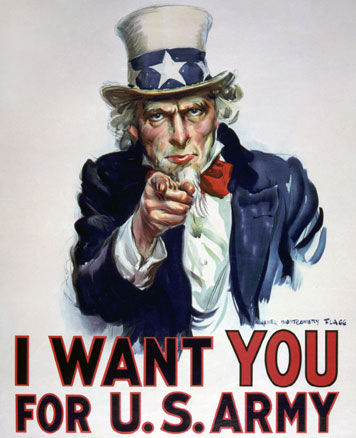
James Montgomery Flagg, lithograph, 1917. (Prints & Photographs Division, U.S. National Archives)
What if Uncle Sam wanted you to design not posters, but services in the war zones of Afghanistan or Iraq? As a design anthropologist, I am always interested in how the processes and artifacts of design help define what it means to be a citizen. Over the past seven years, my focus has been on design and human governance. I've applied anthropologically informed design thinking to support U.S. elections and voting experiences (through Design for Democracy), emergency and evacuation strategies, the IRS's design management of taxation, and, most recently, public health for the Chicago's Bureau of Health Services. But what if I decided to apply design thinking to the U.S. military? What roles could design thinking play in war? A recent The New York Times article, "Army Enlists Anthropologists in War Zone," makes these questions especially relevant.
War is one of the constants of human activity as far back as the pre-historical record. Designed artifacts have certainly played a significant role in war from propaganda posters to the design of weapons. But what about design thinking as it applies to designing social solutions? What if the U.S. Army asked designers to join teams to do "service design" projects in Afghanistan?
The context for my questions is the current debate within the professional anthropology community about the embedding of anthropologists with soldiers in Afghanistan. The Pentagon has started a relatively new program called Human Terrain Teams, in which social scientists are paired with combat soldiers to help translate the cultural environment to inform non-combat decision-making. The participation of anthropologists in this program has generated controversy because anthropology has always branded itself as a "neutral observer" — or if partisan, as an advocate for the powerless. Historically, anthropology's role in the "Colonial Imperial" project makes the discipline wary of aligning itself with powerful military institutions. Pragmatically, the field's code of ethics requires that research participants give informed consent to projects and that knowledge be non-proprietary. Only 25 years ago you could get barred from the American Anthropological Association for working in a for-profit corporation, indicating the seriousness with which anthropologists have protected their "neutral observer" brand.
As a field less complicatedly aligned with powerful institutions, design's history and pragmatics differ from that of anthropology. The emerging emphasis on design thinking for business, government and social institutions makes this anthropological debate relevant to design — at least hypothetically. Following the recent The New York Times article, I posted my thoughts about the controversy and solicited other anthrodesigners' response on the Anthrodesign Yahoo Group listserve. Some anthropologists and social scientists eagerly entered the fray with the pros and cons of participation in this military project. They asked if future anthropologists would be put in danger or if the field would compromise its credibility. With some coaxing, a few designers contributed to the discussion. They mentioned design's role in creating wartime propaganda and weapons. Designers framed the issue of one of personal ethical choice, which contrasted with the anthropologists' interest in larger issues of professional ethics and standards.
Are we, as designers, so individualistic? I say "we" to emphasize that I consider this an insider perspective, not just that of an outside anthropologist. Are there collective ideas for which the profession stands? AIGA did adopt the Universal Declaration of Human Rights in 2006. As design seeks to expand its progressive impact on business, government and society, I wonder if we, designers as thinkers, can continue to afford to see ourselves in such individualistic ways. At the recent AIGA Conference in Denver, Richard Grefé presented how designing now includes form + content + context + time. As the affect of one's designing scales beyond form and content to context and time, the ethical issues scale as well.
I genuinely wonder how the design community would respond if called upon by the U.S. Army to create service designs in Afghanistan. At the University of Illinois at Chicago, I educate "anthro-design" students in research methods and critical theory. For the past two years, over half of the students have selected topics related to ethics and designing. Both undergraduate and graduate students want to understand the role of design in, for example, promoting cultures of fear, commercialism, ecological and social sustainability, and altruistic projects in Africa. They express dissatisfaction when they interview designers who talk about ethics as personal choice. They want designing itself to be ethical. So how prepared is the design field to engage with their ethical expectations? I provide them with the perspective of ethical codes from anthropology. But, what are the ethical codes for design thinking?
So I open up the question, "How should the design community respond if the U.S. Army asked us to join teams to do "service design" projects in Afghanistan?" What if Uncle Sam wants our design thinking?
